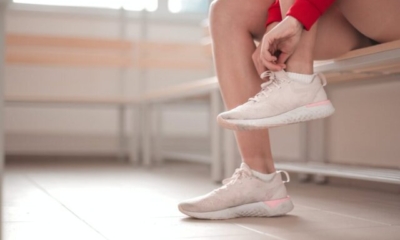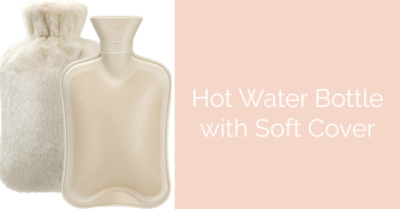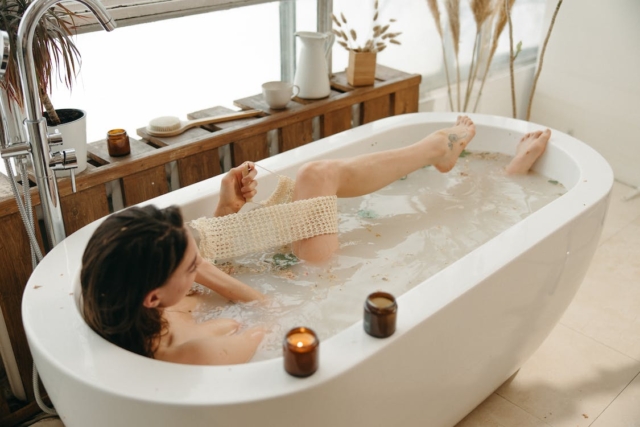4 Simple Ways to Make Exercise a Habit

This article contains some affiliate links to products you may find useful, at no extra costs to you. All opinions are my own.
From ice baths to cold showers, cold exposure has been all the rage over the past few years. But did you know that heat also hosts heaps of health benefits?
By applying warmth to (parts of) your body, heat therapy improves your blood circulation and relaxes your muscles. That’s how applied heat can ease sore muscles and joint pain, but also helps to speed up healing by bringing nutrient-rich blood to the affected area. What’s more, heat therapy lowers your blood pressure and improves your vascular function, which in turn supports good heart health and cognitive functioning, even as you age.
Those benefits sound great, but how can you apply heat therapy at home? And when you’re in pain, how do you know whether you should put a hot pack or some ice on it?
While cold treatments like ice packs are usually advised for acute injuries, heat therapy works best for chronic pain related to stiff joints (like arthritis or lower back pain), muscle spasms and headaches caused by a cramped neck.
You can also use heating pads to ease menstrual cramps and mild abdominal pain.
However, you should not use therapeutic heat when you’re dealing with:
Disclaimer: If you have a history of health problems, always check with your doctor if heat therapy is safe for your condition.
In general, there are two types of heat treatments: dry heat (such as heating pads and saunas) and moist heat (like a warm bath and hot compresses).
Applying moist heat seems to be a little more effective in relieving pain than dry heat, in less time. But you can use any method you find comfortable and soothing. Heat used directly on to your skin should be used for around 20 minutes at a time.
Despite its name, heat therapy should never be hot – only comfortably warm. Make sure the temperature of your hot pack or bath water does not hurt your skin, especially if you apply it locally.
With these precautions in mind, take a look at some heat treatments you can easily try at home.
Got pain in a specific part of your body, like your back or belly? Then these heating pads can help relax your muscles and reduce your aching.

The old-school hot water bottle is a budget-friendly way to relieve pain. You also don’t have to charge it to use it, only fill it with hot water. Just be careful that the bottle does not leak to avoid burns.
Heating pillows filled with dried cherry pits provide a gentle heat that eases sore muscles, joint pain and menstrual cramps. You simply heat the cherry pit pillow for 90 seconds in the microwave and then place it around your neck, behind your back or on your belly.
The downside of using hot water bottles and cherry pit pillows is that they lose heat relatively quickly. If you’re looking for more consistent warmth, you might like electric heating pad. You do have to stay close to a power outlet when you’re applying this type of heat therapy, but you often can control the intensity of the heat with different settings.
Want to be able to move freely despite period pain or a bad endometriosis day? Consider wearing a cordless heating pad around your belly. It heats up quickly, with adjustable temperatures and sometimes even built-in massage options. There are also rechargeable heating pads available to cope with lower back pain.
Struggling to untie the knots in your shoulders, neck or back? A massage cushion with heated rollers can help you to relieve tension in hard to reach places. It gives you deep tissue kneading while providing a soothing warmth on any area that hurts.
If you enjoy (self)massages at home, you could also consider getting a set of hot stones to relax your muscles. However, be mindful that it’s much harder to regulate the heat of these basalt stones than electric hot packs, so avoid burning your skin.
What’s nicer after a tiring day then to soak in a warm bath to release the tension from your body?
Warm baths don’t just relax your muscles, but they also promote good blood flow, which in turn helps to relieve pain. Being immersed in water also calms your nervous system, resulting in less stress, anxiety and depression. What’s more, a hot bath opens up the nasal pathways when you have a cold, and may even help certain immunity cells to function better. Pretty impressive for a taking a bath right?
No bath at home? No worries – taking a hot shower has similar benefits, from a good night’s sleep to better heart and brain health thanks to the natural widening of blood vessels under higher temperatures.
You could even level up your bathing routine by stimulating your blood and lymph flow with dry body brushing before stepping in the shower or bath, or giving yourself a gentle and quick massage while rubbing body lotion on your body after your soak. Also look into adding health-boosting ingredients to your baths that are right for your condition, like Epsom salts, essential oils or herbal infusions.

Saunas have been used as dry heat therapy for thousands of years. Modern science has confirmed that regular sauna bathing has many benefits for your health, like improving your heart health, relieving pain and reducing stress. However, you should always consult your doctor before trying a sauna if you have pre-existing health problems, especially cardiovascular diseases.
There are several types of saunas, from wood-burning to electric and infrared saunas, so see what’s suitable for your personal situation.
If you prefer moist heat, you could also check out the steam room at the gym or inside the spa for some heat therapy.
But no worries if you don’t have access to a sauna, steam room or other spa facilities. As you’ve just seen, there are plenty of option to try heat therapy at home, and hopefully reap some of its benefits.
Tell me, have you ever used heat to relieve pain or support your health? What’s your favorite method or tool?
Get inspired by these ideas to turn your tub time into a health-boosting ritual, or check out more wellness strategies to boost your overall wellbeing.